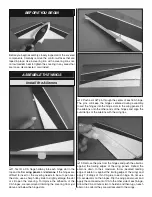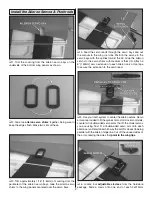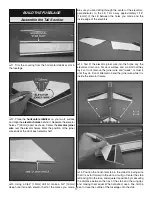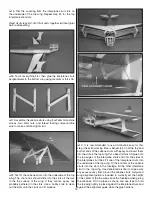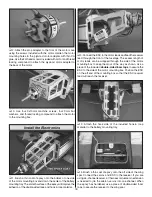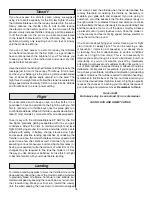
17
❏
2. Fit a 3x20mm machine screw (axle) through the hole in
the
landing gear
and through the hole in the wheel pant (the
angled side of the landing gear faces the rear of the plane).
Thread a 3mm nut onto the screw followed by a wheel.
Apply a drop of thread locking compound near the base of
the screw and tighten the nut against the inside of the pant.
Apply a drop of thread locking compound near the end of
the screw. Thread another 3mm nut onto the screw against
the wheel, but left slightly loose to allow the wheel to freely
rotate on the axle. Oil the axle if necessary. Repeat this step
for the other side of the gear.
❏
3. Trim the covering from the three landing gear mounting
holes on the underside of the fuselage. Mount the landing
gear to the fuse with three 3x12mm machine screws and
thread locking compound. Rotate the wheel pants on the
axles so that they align with the fuselage.
❏
4. Use a hobby knife to cut the covering over the slot in the
bottom of the
tail skid
. Glue the tail skid washer into the slot
as shown. The washer will help to prevent wear to the skid
when fl ying from a paved runway.
❏
5. Position the tail skid approximately 1/4" [6mm] from the
aft end of fuselage and mark its position. Trim a 3/32" [2.4mm]
strip of covering down the center of the fuselage between
the marks you made. Trim the covering that overlaps onto
the longest side of the tail skid and glue the skid in place.
Install the Out-Runner Motor
❏
1. Install four 3mm blind nuts into the back of the motor
mounting box. Use a 3x10mm machine screw, 3mm fl at washer,
and a
plywood motor adapter
to draw the blind nuts tight (the
motor adapter is necessary for this step because the blind nuts
will protrude slightly beyond the front of the mounting box).





